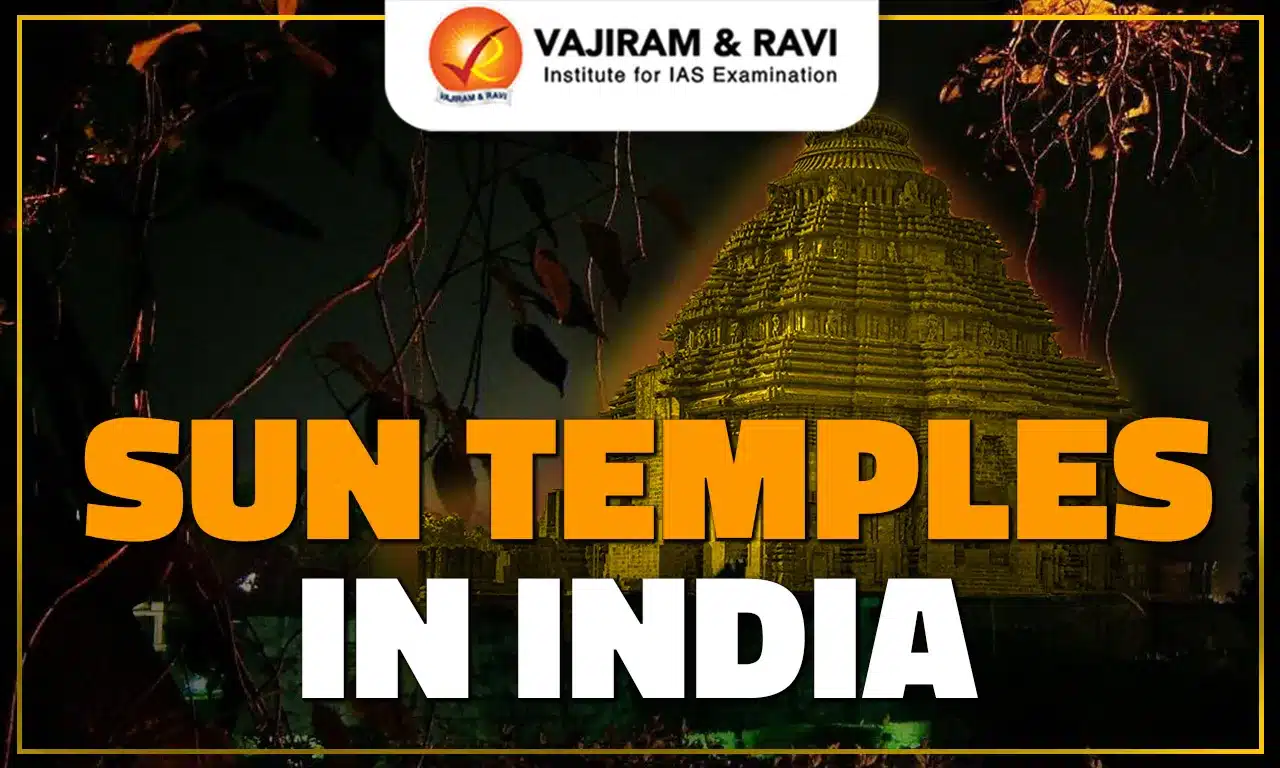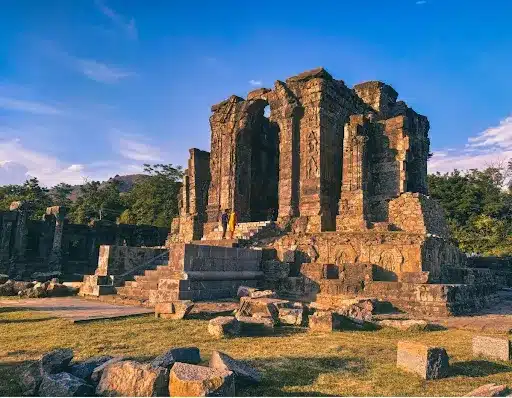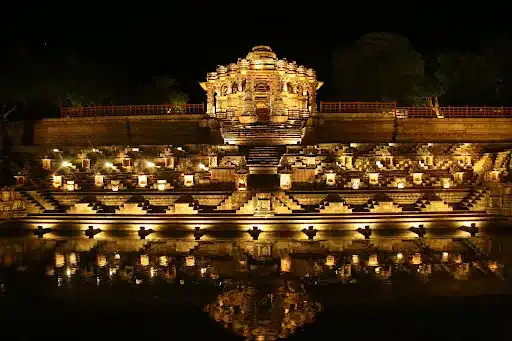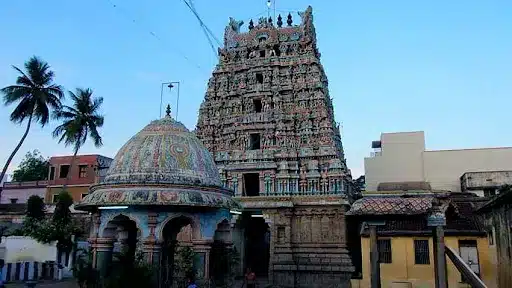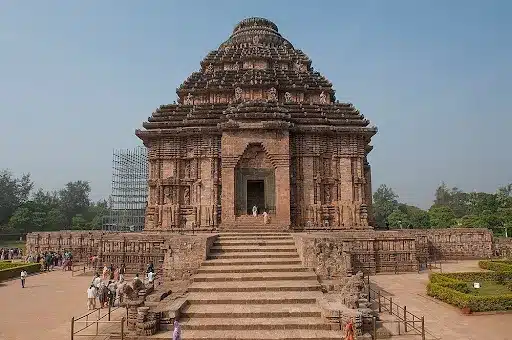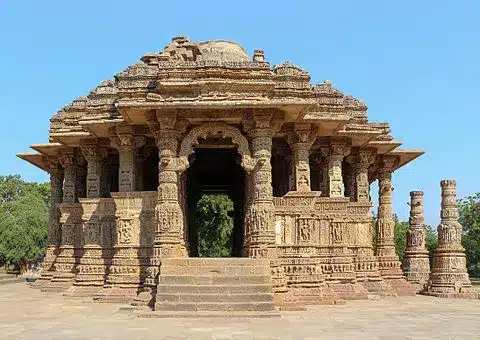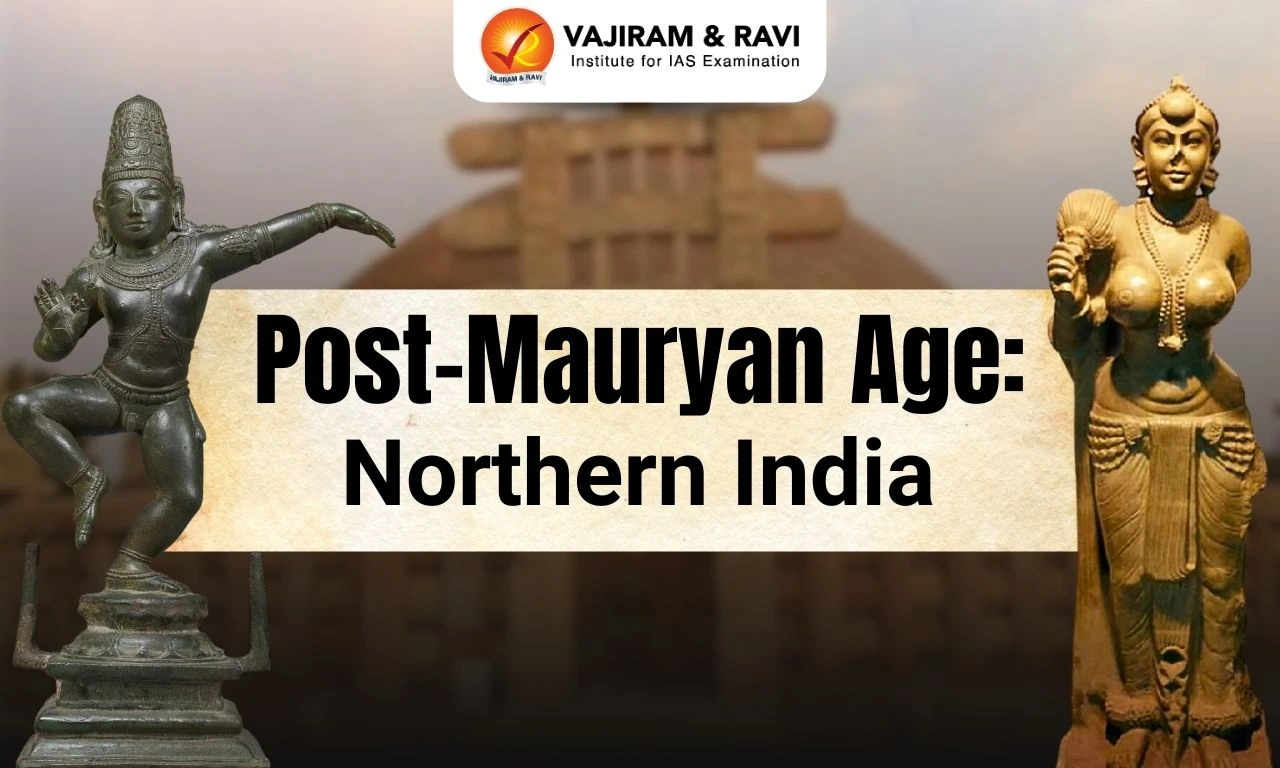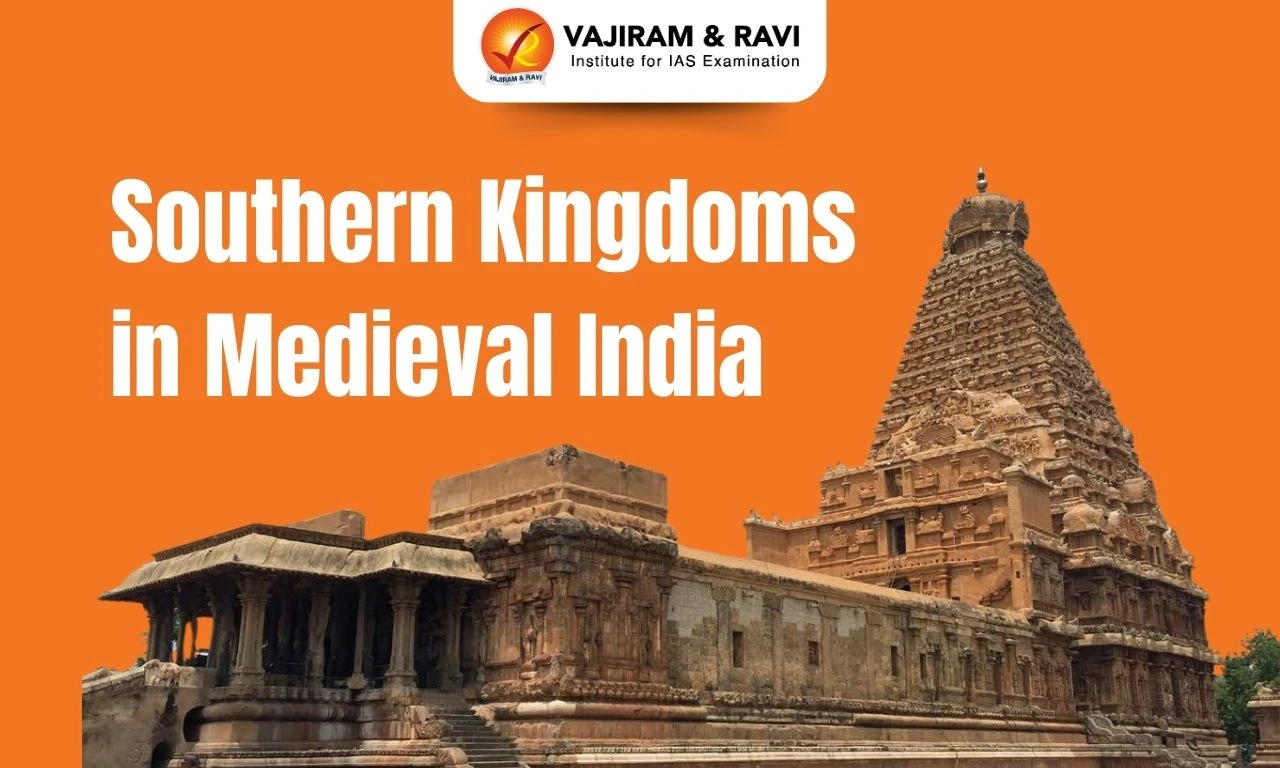Sun Temples in India, dedicated to the Hindu deity Surya, are remarkable architectural marvels, with the most prominent being the Konark Sun Temple in Odisha and the Modhera Sun Temple in Gujarat. These Sun Temples symbolise the importance of sun worship in early Hinduism.
Sun Temples in India remain vital cultural relics, showcasing the grandeur of ancient Indian architecture and religious practices. In Manipuri mythology, the sun god Korouhanba is equated with Surya, further reflecting his widespread influence across various regions.
Sun Temple
Sun temple, also known as solar temple, is a sacred structure designed for religious or spiritual practices, including rituals, prayers, and offerings, centred around the worship of the sun or a solar deity.
- Various civilisations worldwide have constructed such temples, with notable examples found in India, China, Egypt, Japan, and Peru.
- While some of these temples remain in well-preserved condition, others are in ruins, undergoing excavation, preservation, or restoration efforts.
- A few of these iconic temples, such as the Konark Sun Temple in India, have been recognised as UNESCO World Heritage Sites, either independently or as part of larger cultural complexes.
Sun Temples in India Background
Sun Temples in India have a rich history, reflecting the importance of the sun deity, Surya, in Hinduism. Various dynasties across India constructed temples dedicated to different gods, often to honour their beliefs, fulfil vows, or commemorate victories over enemies. Among these, several Sun Temples were built during different periods.
- Origin of God Surya in Vedic Period: In Hinduism, Surya deva has been identified with many names such as Aditya, Arka, Ravi, Prabhakar, etc. God Surya is mentioned in the Rig Veda and also in subsequent Vedic literature and Upanishads.
- Significance of God Surya: The Sun has always been a symbol of knowledge, power, and clarity. God Surya is regarded as the dispeller of darkness and the source of illumination in one's life.
- Role of Sunlight in Sun Temples: Sun temples are always associated with light. The position of the deity is always correlated with light. The Sun temple of Modhera and the Sun temple of Konark are the temples where sunlight directly falls on the deity.
Famous Sun Temples in India
Famous Sun Temples in India include temples like the iconic Sun Temple at Konark in Odisha and the magnificent Sun Temple at Modhera in Gujarat. These temples, dedicated to Surya, the Sun God, showcase India’s ancient sun-worship traditions. While some remain well-preserved, others lie in ruins, yet they continue to symbolise India’s rich cultural heritage.
Martand Sun Temple
Martand Sun Temple is a significant Hindu shrine situated close to Anantnag in the Kashmir Valley, part of the union territory of Jammu and Kashmir, India. The temple, believed to have been built in the 8th century, honours Surya deva, also known by the Sanskrit name Martand. Unfortunately, the Martand Sun Temple faced destruction at the hands of Sikandar Shah Miri.
- Built by: The temple was built by Lalitaditya Muktapida of the Karkota dynasty, who ruled Kashmir during the 8th century AD.
- Location: Anantnag region of Kashmir.
- Architecture: The Martand Sun Temple is a remarkable example of Kashmiri architecture, seamlessly combining elements of Gandharan, Gupta, and Chinese architectural styles.
- Features: Built from finely sculpted black stone, the temple showcases the grandeur of early medieval Indian architecture.
- The use of black stone imparts a sense of strength and permanence to the structure, amplifying its imposing stature against the gentle landscape around it.
- The contrast between the dark material and the surrounding environment accentuates the intricate architectural details and artistic features of the temple.
Modhera Sun Temple
Modhera Sun Temple is a remarkable Hindu temple dedicated to the solar deity Surya, located in Gujarat along the banks of the river Pushpavati. The temple was constructed in the early 11th century during the Chalukya dynasty. In 2014, the Modhera Sun Temple was added to the list of UNESCO World Heritage Sites.
- Location: The Modhera Sun Temple is located at Modhera village in the Mehsana district of Gujarat. It is situated along the banks of the river Pushpavati.
- Built by: The Modhera Sun Temple was built between 1026-27 CE, during the rule of King Bhima I of the Chalukya (Solanki) Dynasty.
- Architectural Style: The Modhera Sun Temple complex is constructed in the Maru-Gurjara style, also known as the Chalukya style.
- The entire Sun Temple complex, standing on a kharasila (basement), consists of the garbhagriha (shrine) and guha-mandapa (hall), along with the sabha-mandapa or ranga-mandapa (assembly hall), locally known as Sita Chavadi.
- In front of the Sun Temple lies the Kunda (sacred pond), which has been renamed Ramakunda.
- Various small shrines featuring images of gods and goddesses, such as Jalasayi Vishnu, Trivikrama, and Goddess Shitala, are located on its sides and corners.
- Between the outer walls of the sanctum sanctorum and the temple is the pradakshina-marga (circumambulatory passage).
- This east-facing Modhera Sun Temple is constructed from bright yellow sandstone.
- Sculptural Features: The exterior of the Modhera Sun Temple is also profusely sculptured. The sabha mandapa is carved with scenes from the Mahabharata. The inner walls of the Sun Temple have been broken, which were once decorated with idols of Surya.
Katarmal Sun Temple
Katarmal Sun Temple, located in Uttarakhand, India, is a remarkable example of 9th-century architecture built by the Katyuri Kings. This unique temple complex features a main shrine dedicated to the solar deity Surya, surrounded by numerous smaller shrines and other deities.
- Location: The Katarmal Sun Temple is located in the Almora district of Uttarakhand.
- Built by: The Katarmal Sun Temple was constructed by Katarmalla, a Katyuri Raja, in the 9th century.
- Features: The Katarmal Sun Temple complex includes one major temple surrounded by 45 smaller shrines and elegantly carved temples nearby.
- Moreover, the site is adorned with artistically crafted stone and metal sculptures, as well as beautifully carved pillars and wooden doors.
- Katarmal Sun Temple is recognised for its historical significance and has been declared a monument of national importance under the Ancient Monuments and Archaeological Sites and Remains Act of 1958.
Suryanar Kovil Temple
Suryanar Kovil Temple, also known as Suryanar Temple, is a Hindu temple dedicated to the Sun God, Surya, located in the village of Suryanar Kovil in Tamil Nadu, India. Built in the 11th century, it showcases Dravidian style architecture and continues to serve devotees through daily rituals and annual festivals.
- Built: Suryanar Kovil was constructed in the 11th century during the reign of Kulottunga Choladeva (1060-1118 CE). In those days, Suryanar Temple was known as Kulottungachola-Marttandalaya.
- Deities: Suriyanar, the Sun God, is the presiding deity of the temple, accompanied by his consorts, Ushadevi and Pratyusha Devi. The temple also houses individual shrines for the other eight planetary deities, making it one of the revered Navagraha temples in Tamil Nadu.
- Architectural Style: Suryanar Kovil is distinguished by its Dravidian style of architecture.
- This Sun Temple showcases a five-tiered gopuram, serving as a grand gateway tower, along with magnificent granite walls that encircle all of the shrines on the premises.
Konark Sun Temple
Konark Sun Temple, a 13th-century Hindu temple located in Odisha, India, is dedicated to the Sun God, Surya. Attributed to King Narasingha Deva I of the Eastern Ganga dynasty, the temple complex is designed to resemble a magnificent chariot, complete with intricately carved wheels and horses.
- Built: Also known as Black Pagoda, the Konark Sun Temple was constructed in the 13th century CE by Narsingha Deva I of the Eastern Ganga dynasty.
- Materials used: Chlorite, Laterite, and Khondalite rocks.
- Architectural Style: The Konark Sun Temple is aligned on an east-west axis and showcases the Odisha style of architecture, also known as Kalinga architecture.
- This Sun Temple is designed so that the first rays of the rising Sun fall directly on the main entrance, reflecting off a diamond placed at the center of the idol in the sanctum.
- The Konark Sun Temple is crafted in the form of a decorated chariot, mounted on 24 intricately designed wheels, and drawn by seven mighty horses.
- Components: Its components include the Nata Mandir, or dancing hall; the Jagmohan, or assembly hall; and the sanctum, each of which contributes to the temple's grandeur.
- World Heritage Site: Konark Sun Temple was declared a UNESCO World Heritage Site in 1984 and continues to be a significant pilgrimage site for Hindus.
Dakshinaarka Temple
Dakshinaarka Temple, also known as the Sun Temple in Gaya, is an ancient shrine referenced in the Hindu religious text Vayu Purana. Renowned for its simplicity, the temple serves as a vital pilgrimage site for devotees performing pind daan rituals.
- Built: Dakshinaarka Temple was built in the 13th century in Gaya, by South Indian emperor Prataparudra of Warangal.
- Components of the temple: The Dakshinaarka Sun Temple has the Surya Kunda tank located to the east of the temple.
- This Sun Temple itself is simple and plain, topped with a dome.
- In front of the sanctum is the larger sabha mandapa, which is lined with massive pillars that house graceful stone sculptures of Shiva, Brahma, Vishnu, Surya, and Durga.
- There are two other notable Sun temples at Gaya, namely the Uttaraka Sun Temple near the Uttara Maanas tank and the Gayaditya Temple on the river Falgu.
Arasavalli Sun Temple
Arasavalli Sun Temple serves as the prominent Sun Temple, located in the in Arasavalli Village, in Andhra Pradesh. This Sun Temple is renowned for its Rekha deula style of Kalinga architecture. It is also considered one of the oldest sun temples in India.
- Location: Arasavalli Sun Temple is located in Arasavalli Village, approximately 1 km east of Srikakulam in the Indian state of Andhra Pradesh.
- Built: Arasavalli Sun Temple was built by Devendra Varma, the ruler of the Eastern Ganga Dynasty of Kalinga in the 7th century CE.
- Architectural Style: Arasavalli Sun Temple, built in the Rekha deula style of Kalinga architecture, highlights the craftsmanship of the Vishwakarma Brahmins or Maharanas of Odisha.
- The temple is built in such a way that the sun's rays focus on the feet of the deity twice a year during Uttarayan from March 9 to 11 and Dakshinayan from October 1 to 3, even when the five entrance gates are closed.
- As per the Padmapuranam, Sage Kasyapa is credited with consecrating the idol of Surya at Arasavalli to ensure the well-being of humanity.
- Consequently, Surya is associated with the Kasyapasa Gotra and is revered as the King of Planets.
- The temple's Sthalapuranam (local legend) further recounts that Lord Devendra established this temple and enshrined the current idol of Lord Suryanarayana Swamy.
- This divine installation occurred under unique circumstances, as described in the temple's sacred lore.
Bhramanya Dev Temple
Bhramanya Dev Temple, also known as the Surya Temple, is located in Unao, Datia district, Madhya Pradesh. Dedicated to Lord Surya, the temple features a stone idol of the Sun God standing on a brick platform adorned with black plates.
- The shrine's sanctum is engraved with twenty-one triangles, symbolizing the 21 phases of the sun, and the idol is protected by a brass cover.
- Local beliefs attribute healing powers to the temple, particularly for skin ailments, blindness, and leprosy.
- Devotees often bathe in the nearby Pahooj River, whose sulphur-rich waters are thought to aid in curing skin diseases.
Surya Pahar Temple
Surya Pahar Temple, located near Goalpara in Assam on the Banks of Brahmaputra River, is an ancient archaeological and religious site known for its unique blend of Hindu, Buddhist, and Jain heritage. The site features thousands of rock-cut Shiva Lingas, Buddhist stupas, and Jain sculptures scattered across hilly terrain.
- It is believed to have once housed a Sun temple, as referenced in ancient texts, and served as a major center for worship and culture from the 5th to 12th centuries CE.
- Sri Surya Pahar stands out for its harmonious coexistence of multiple faiths and its significant contribution to Assam’s historical and spiritual legacy.
Sun Temples in India PYQs
Question 1: Which of the following is/are famous for Sun temples? (UPSC Prelims 2017)
- Arasavalli
- Amarkantak
- Omkareshwar
Select the correct answer using the code given below:
(a) 1 only
(b) 2 and 3 only
(c) 1 and 3 only
(d) 1, 2 and 3
Answer: (a)
Last updated on December, 2025
→ Check out the latest UPSC Syllabus 2026 here.
→ Join Vajiram & Ravi’s Interview Guidance Programme for expert help to crack your final UPSC stage.
→ UPSC Mains Result 2025 is now out.
→ UPSC Notification 2026 is scheduled to be released on January 14, 2026.
→ UPSC Calendar 2026 is released on 15th May, 2025.
→ The UPSC Vacancy 2025 were released 1129, out of which 979 were for UPSC CSE and remaining 150 are for UPSC IFoS.
→ UPSC Prelims 2026 will be conducted on 24th May, 2026 & UPSC Mains 2026 will be conducted on 21st August 2026.
→ The UPSC Selection Process is of 3 stages-Prelims, Mains and Interview.
→ UPSC Result 2024 is released with latest UPSC Marksheet 2024. Check Now!
→ UPSC Prelims Result 2025 is out now for the CSE held on 25 May 2025.
→ UPSC Toppers List 2024 is released now. Shakti Dubey is UPSC AIR 1 2024 Topper.
→ UPSC Prelims Question Paper 2025 and Unofficial Prelims Answer Key 2025 are available now.
→ UPSC Mains Question Paper 2025 is out for Essay, GS 1, 2, 3 & GS 4.
→ UPSC Mains Indian Language Question Paper 2025 is now out.
→ UPSC Mains Optional Question Paper 2025 is now out.
→ Also check Best IAS Coaching in Delhi
Sun Temples in India FAQs
Q1. How many Sun temples are there in India?+
Q2. Which is the largest Sun Temple in India?+
Q3. Which is the best Sun Temple in India?+
Q4. Which is the first Sun Temple in India?+
Q5. Which city is known as Sun Temple?+



